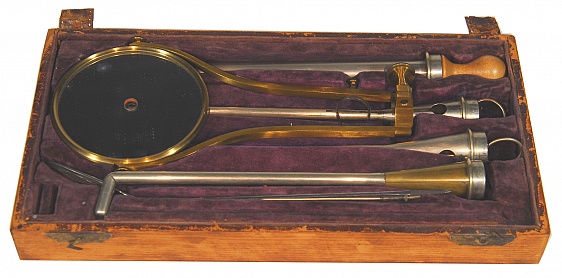
- The Instruments Open Instruments menu
- 19th Century Medicine
- Medical Collectors Association(MCA)
- Curator
- Bibliography
- Glossary

Category: Urology
Estimated Date: 1868
Name: Wales Endoscope
Manufacturer: Horatio G. Kern
Description: 12” x 6“x 2” wooden box with leather cover embossed Wales Endoscope. Contains red velvet lining with four 9” tubes of varied diameter, 1 with right angle and 1” extension, as well as obturators. There is a 3.5” mirror on a brass stand with an attachment for a lens and a clamp to go on the end of the urethroscope. Two lenses are missing. There is a knife and possible caustic holder. Tiemann in the catalog listed as a reference illustrates the Otis endoscopic tube. One of the tubes in the Wales outfit is virtually identical. Extremely important historic piece in urology. This is one of the earliest cystoscopes and is notable because it has an American inventor. Uses reflected light to see. Probably gave very poor visualization but it was noteworthy for the early prototype role that it served. Philip Skinner Wales. of Washington, DC, was born February 27, 1837, in Annapolis.He served as General of the Navy and Chief of the Bureau of Medicine and Surgery from 1880 to 1884. He described the Wales Endoscope in the Philadelphia Medical and Surgical Reporter, June 13, 1868. He describes his instrument “As furnished by Mr. GEMRIG of Philadelphia, the case contains the illuminating mirror, urethral, vesical, and rectal tubes, a stricture knife, porte caustic, and a twisted-pointed wire stylet.The peculiarity of the instrument is the mode of illumination, which is effected by a concave mirror three inches in diameter and ten inches focal length, perforated at its centre. The mirror is supported in a metallic frame, consisting of a broad ring, which is intended to slip over the proximal end of the tube; two slender arms about five inches long, project posteriorly from the ring, and clasp the mirror at opposite points of its periphery, where the connection is secured by two little milled headed screws. By this arrangement, the mirror is movable around its vertical and central axes, so that it can be set at any desired angle to receive the light which is to be conveyed into the tube.
The source of light may be either natural or artificial. Sunlight yields the best results, enabling the observer to see distinctly the minutest details of the field under observation. As it is impossible in the majority of cases to use sunlight, a gasalier may be employed. In my examinations, I prefer TOBOLD’S modification of the common reading lamp, with which the light may be concentrated upon the mirror.” He states that his instrument is an improvement on Warwicks, which did not have an adequate source of illumination.”
Reference 1: 442













